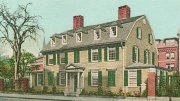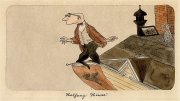With 90 Mount Auburn Street, avant-garde Harvard Square may soon be home to one of the architectural “gems” that Pritzker Prize-winner Hans Hollein is famous for in Vienna. Harvard selected Hollein, says Scott Levitan, director of University and commercial real estate, “because the core of his work has been modern buildings in the heart of baroque Vienna—modern expressions that are nevertheless integrated with the historic fabric of the city.” With co-architects Bruner/Cott & Associates Inc. of Cambridge, Hollein has created a building that strives to be “contextual” despite the modernism of its wave-form façade. “Contextualism says that there is a legitimate modern language of design,” explains Levitan, “that one doesn’t have to build only Georgian revival in order to be contextual—that in fact, if one operates in that faux historicist mode, it is possible to lose sight of what is real and what is a copy.” Levitan and the architects have been working with Peter Rowe, dean of the Graduate School of Design (GSD), and local authorities to get preliminary feedback on the design.
Hollein’s building is small, in scale with the neighboring Fox and former D.U. clubhouses. Though the exterior side walls are bronze, they are of the same tone as the surrounding brick, says GSD faculty member Lee Cott, M.A.U. ’70, of Bruner/Cott. The north-facing, sloped-glass façade is screened with a metal mesh made of vertical bronze rods interwoven with horizontal cables of stainless steel. Rectangular glass boxes centered on the façade serve as a division that breaks up the wave-forms, says Cott, who designed the copper ornament on the Office for the Arts building in the next block (see “Light Catcher,” September-October 1998, page 75).
Consistent with Harvard Square overlay-district guidelines, retail space is planned for the ground floor, perhaps with a restaurant in back where the design calls for a courtyard. (The site has long housed University Typewriter and Harvard Provision Company.) The rest of the building will be office space. And though the probable tenants upstairs will be Harvard University Library administrators relocated from Wadsworth House (who know all about historic fabric) and the library’s Weissman Preservation Center, Bruner/Cott representatives say any resemblance between the new building and an open book is not intentional.





